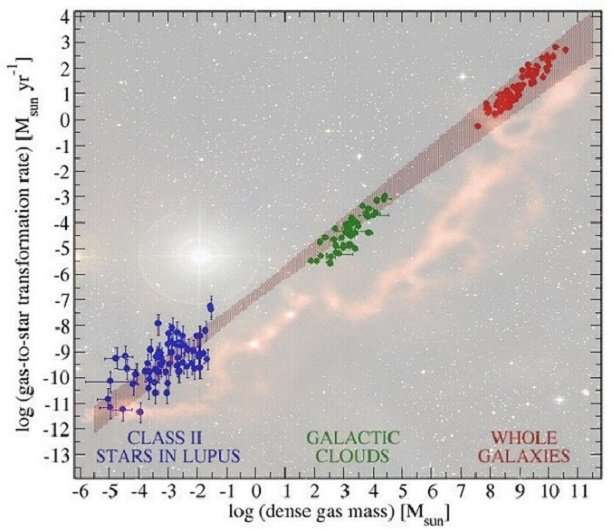Credit: Astronomy & Astrophysics
Star formation is one of the most important research fields in astrophysics. This process, in which gravitational instabilities cause the collapse of gas to form more compact structures and finally stars, encompasses a broad range of physical scales. These include star-forming galaxies on the large scale, individual young stars with envelopes and circumstellar disks on the smaller scale, and intermediate scales that include giant molecular clouds and protostellar cores.
In the last decades of the 20th century, astronomers established a well-known star formation relation for the intermediate-large scales called the Kennicutt-Schmidt Law. More recent versions of this law establish that the so-called star formation rate (SFR), which measures the pace at which stars are formed in a galaxy or a molecular cloud, is proportional to the amount of dense gas mass present in that galaxy or molecular cloud. The previous relation confirms that the star formation rate measured in galaxies is related to the mass of gas that is transformed into stars, which are located in the molecular clouds that those galaxies host, given that it is here where the material that will form stars is found.
On the other hand, at the small scale of star formation, it is also known that there is a correlation between the mass accretion rate, which measures the pace at which circumstellar gas falls on to a star in formation, and the mass of the protoplanetary disks that surround young stars. It is only recently that this second correlation has been confirmed observationally, at least in the star forming regions where both parameters have been measured accurately.
In a work recently published in the Astronomy & Astrophysics journal and led by researcher Ignacio Mendigutía, the authors have compiled the available data for the SFRs and the dense gas masses of a sample of galaxies and a representative group of molecular clouds within the Milky Way, and the available data for the accretion rates and disk masses of a representative sample of young stars also in our galaxy.
What they have found is surprising. A unique correlation emerges between the data compiled, encompassing no less than 16 orders of magnitude and relating very different physical scales: individual, young stars, molecular clouds, and galaxies. Mendigutía says, "We have found a correlation between the pace at which gas transforms into stars and the dense gas mass directly associated to star formation. This is probably one of the widest empirical relations ever observed, given that it encompasses an enormous range of scales: from sizes of hundreds of thousands of light-years in galaxies, to sizes comparable to our solar system in stars."
The researchers suggest a "bottom-up" hypothesis to explain this discovery and propose future observations to test it. According to their hypothesis, the correlation in galaxies and molecular clouds would result from the smaller-scale relation between the individual stars hosted by them. "After the initial surprise, the fact that what we observe in individual stars correlates with whole galaxies is what one would expect if measurements on both scales are correct," concludes Mendigutía.
More information: I. Mendigutía et al. A global correlation linking young stars, clouds, and galaxies, Astronomy & Astrophysics (2018). DOI: 10.1051/0004-6361/201833166
Journal information: Astronomy & Astrophysics
Provided by Astronomy & Astrophysics
























